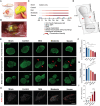Establishment of a Magnetically Controlled Scalable Nerve Injury Model
- PMID: 39287118
- PMCID: PMC11538664
- DOI: 10.1002/advs.202405265
Establishment of a Magnetically Controlled Scalable Nerve Injury Model
Abstract
Animal models of peripheral nerve injury (PNI) serve as the fundamental basis for the investigations of nerve injury, regeneration, and neuropathic pain. The injury properties of such models, including the intensity and duration, significantly influence the subsequent pathological changes, pain development, and therapeutic efficacy. However, precise control over the intensity and duration of nerve injury remains challenging within existing animal models, thereby impeding accurate and comparative assessments of relevant cases. Here, a new model that provides quantitative and off-body controllable injury properties via a magnetically controlled clamp, is presented. The clamp can be implanted onto the rat sciatic nerve and exert varying degrees of compression under the control of an external magnetic field. It is demonstrated that this model can accurately simulate various degrees of pathology of human patients by adjusting the magnetic control and reveal specific pathological changes resulting from intensity heterogeneity that are challenging to detect previously. The controllability and quantifiability of this model may significantly reduce the uncertainty of central response and inter-experimenter variability, facilitating precise investigations into nerve injury, regeneration, and pain mechanisms.
Keywords: animal model; magnetic control; neuropathic pain; peripheral nerve injury (PNI).
© 2024 The Author(s). Advanced Science published by Wiley‐VCH GmbH.
Conflict of interest statement
X.L., W.W., and S.C. are inventors of CN Patent Application ZL 201910709478.4, ZL 202010727396.5, ZL 202110257070.5, and ZL 202210815021.3, which covers the mClamp, magnetic control unit and are assigned to Jilin university. The remaining authors declare no competing interests.
Figures




References
-
- a) Basbaum A. I., Bautista D. M., Scherrer G., Julius D., Cell 2009, 139, 267; - PMC - PubMed
- b) Julius D., Basbaum A. I., Nature 2001, 413, 203; - PubMed
- c) Donnelly C. R., Jiang C., Andriessen A. S., Wang K., Wang Z., Ding H., Zhao J., Luo X., Lee M. S., Lei Y. L., Maixner W., Ko M. C., Ji R. R., Nature 2021, 591, 275; - PMC - PubMed
- d) Gold M. S., Gebhart G. F., Nat. Med. 2010, 16, 1248; - PMC - PubMed
- e) Serger E., Luengo‐Gutierrez L., Chadwick J. S., Kong G., Zhou L., Crawford G., Danzi M. C., Myridakis A., Brandis A., Bello A. T., Muller F., Sanchez‐Vassopoulos A., De Virgiliis F., Liddell P., Dumas M. E., Strid J., Mani S., Dodd D., Di Giovanni S., Nature 2022, 607, 585. - PubMed
-
- a) Haroutounian S., Nikolajsen L., Bendtsen T. F., Finnerup N. B., Kristensen A. D., Hasselstrom J. B., Jensen T. S., Pain 2014, 155, 1272; - PubMed
- b) Zhong W., Ma X., Xing Y., Kim D. K., Wang A., Jiang W., Xu T., Neurosci. Lett. 2020, 716, 134643; - PubMed
- c) Challa S. R., Int. J. Neurosci. 2015, 125, 170; - PubMed
- d) Finnerup N. B., Kuner R., Jensen T. S., Physiol. Rev. 2021, 101, 259; - PubMed
- e) Scheib J., Hoke A., Nat. Rev. Neurol. 2013, 9, 668. - PubMed
-
- a) Dahlin L. B., Zimmerman M., Calcagni M., Hundepool C. A., van Alfen N., Chung K. C., Nat. Rev. Dis. Primers 2024, 10, 37; - PubMed
- b) Padua L., Coraci D., Erra C., Pazzaglia C., Paolasso I., Loreti C., Caliandro P., Hobson‐Webb L. D., Lancet Neurol. 2016, 15, 1273; - PubMed
- c) Padua L., Aprile I., Caliandro P., Mondelli M., Pasqualetti P., Tonali P. A., Neurology 2002, 59, 1643. - PubMed
-
- Nabaei V., Chandrawati R., Heidari H., Biosens. Bioelectron. 2018, 103, 69. - PubMed
MeSH terms
Grants and funding
- 82271414/National Natural Science Foundation of China
- 2023DJ03/19th Innovative Entrepreneurial Talent Project of Jilin Province
- 2023C040-4/2023 Jilin Provincial Budgeted Capital Construction Fund (Innovation Capacity Building) Project
- YDZJ202302CXJD060/Science and technology innovation platform fund of Jilin Province
LinkOut - more resources
Full Text Sources
Medical
